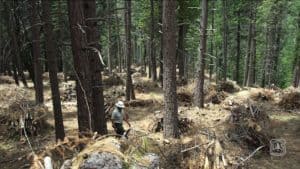This article from Missoulian reporter Rob Cheney offers a real-world look at a thinning/restoration project.
James Stoker compared his log landing piles to sorting change in his pocket.
“That’s the nickels, that’s the dimes, that’s the quarters,” he said, pointing at stacks of de-limbed trees destined to become tipi poles, fence posts, firewood and lumber. “The pennies go to Bonner.”
Those “pennies” — trunks too spindly to make a single 2×4 — used to remain on the hillsides above Gold Creek when Plum Creek Timber Co. and its predecessors were cutting massive pine trees for the plywood mills in Bonner. Today, the mill yard is covered in pennies, and Stoker and his brother Mike make a living cutting, sorting and selling the logs they once left behind.
Instead, what they leave behind are slopes with mature western larch, Ponderosa pine and Douglas fir trees spaced 30 to 50 feet apart at random intervals. The spacing mimics the stumps of the old-growth trees cut in the industrial logging days.
“This is not a timber sale,” BLM Forester Kyle Johnson said. “It’s a stewardship project. It’s based on the relationship we have built with the Stokers, and the relationships they have with small mills.”
Without those relationships, BLM would need to spend between $700 and $1,500 an acre to thin the forest. Finding markets for the little trees, and loggers to cut them, brings the taxpayer cost down to $60 an acre, Johnson said.
…
